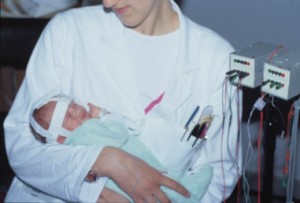Most eye diseases can be prevented or, if diagnosed early, can be treated and monitored to ensure good quality of vision and, thus, a better quality of life.
VISUAL PREVENTION CALENDAR
There are certain moments in our lives, our own and especially those of our children, when it would be appropriate to devote some time and attention to our eyes.
We advise you not to miss these 'appointments':
 At birth or at the latest within the first 6 months of life
At birth or at the latest within the first 6 months of life
An initial visual check to exclude malformations and/or congenital diseases is advisable.
This first examination should include the red reflex test o Bruckner test to diagnose a possible congenital cataract and, in the case of children born at term, can be performed by the paediatrician or family doctor.
This first visit becomes absolutely needed and must be done by first 4 weeks of life in certain special cases:
- infants 'at risk', i.e. born pre-term who may develop retinopathy of prematurity (ROP)
- infants who have a family history of retinoblastoma, congenital glaucoma, childhood cataract, retinal degeneration/dystrophy or systemic diseases associated with eye problems
- if any opacity of the dioptric media is observed
- if you notice an involuntary rhythmic oscillation of the eyes (nystagmus).
In all these circumstances, the first visual inspection should be carried out by an ophthalmologist.
A check-up around the age of 3
This examination serves to assess the harmonious morphological and functional development of the eyes.
The paediatrician or family doctor can also examine vision and eye alignment, but when possible, it is recommended to have this check performed by an ophthalmologist, orthoptist or health personnel specifically trained in pre-school visual examination. Children with neurodevelopmental delays in particular should be examined by an ophthalmologist.
Among other things, a first check of thevisual acuitybut only in co-operative children, an aptitude that generally develops between two and a half and three years of age.
 School-age controls
School-age controls
It is recommended that a first comprehensive visual acuity test be carried out before the age of 5 or at least within the first few years of schooling, in order to diagnose any refractive defects (myopia, hypermetropia, astigmatism) or changes in ocular motility at an early stage. In any case, children showing visual difficulties or fatigue should be examined by an ophthalmologist.
Controls between the ages of 25 and 40
Asymptomatic adults may have an eye examination on average every five years for the sole purpose of monitoring the health of their eyes.
Dr. Carmelo Chines
Direttore responsabile

